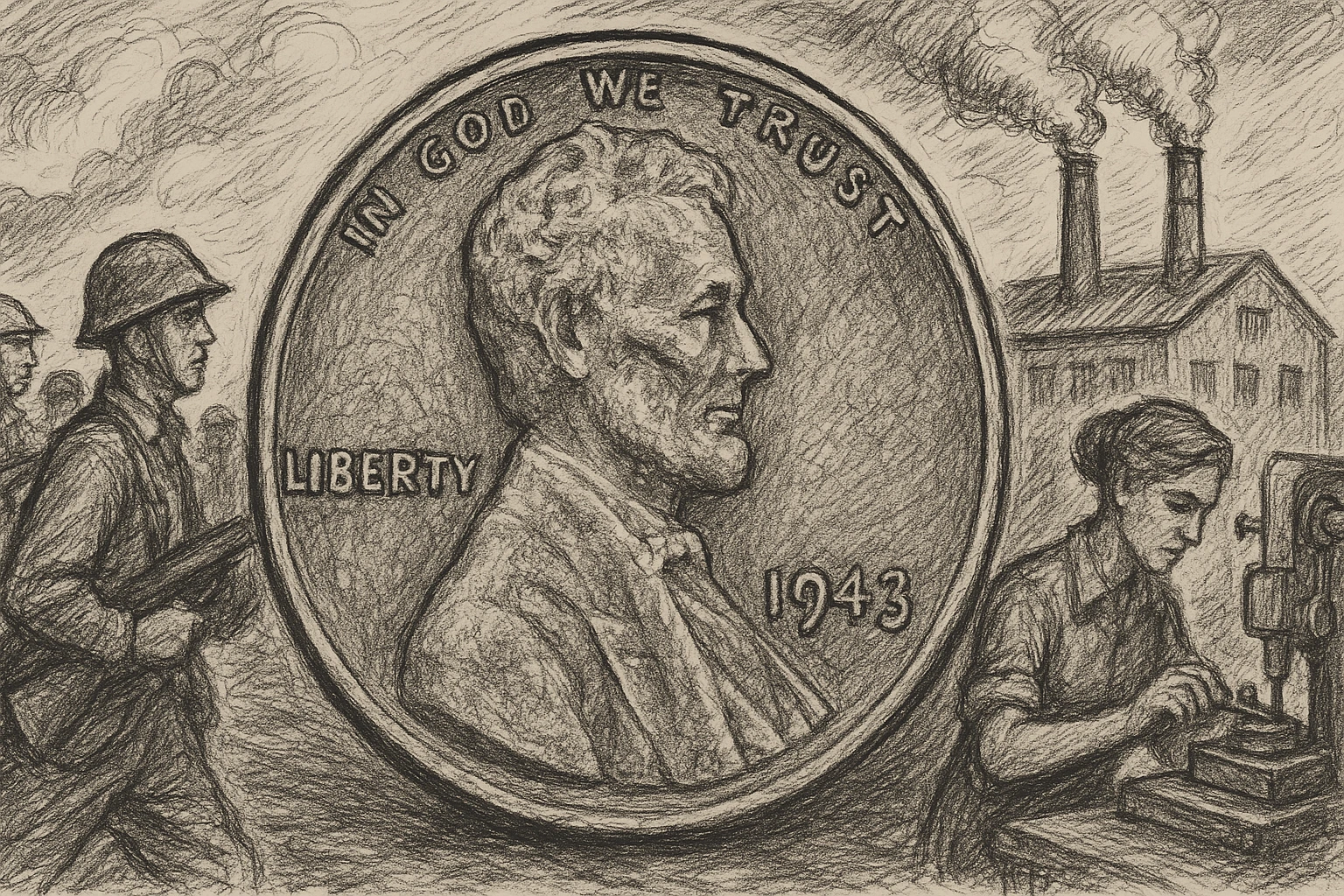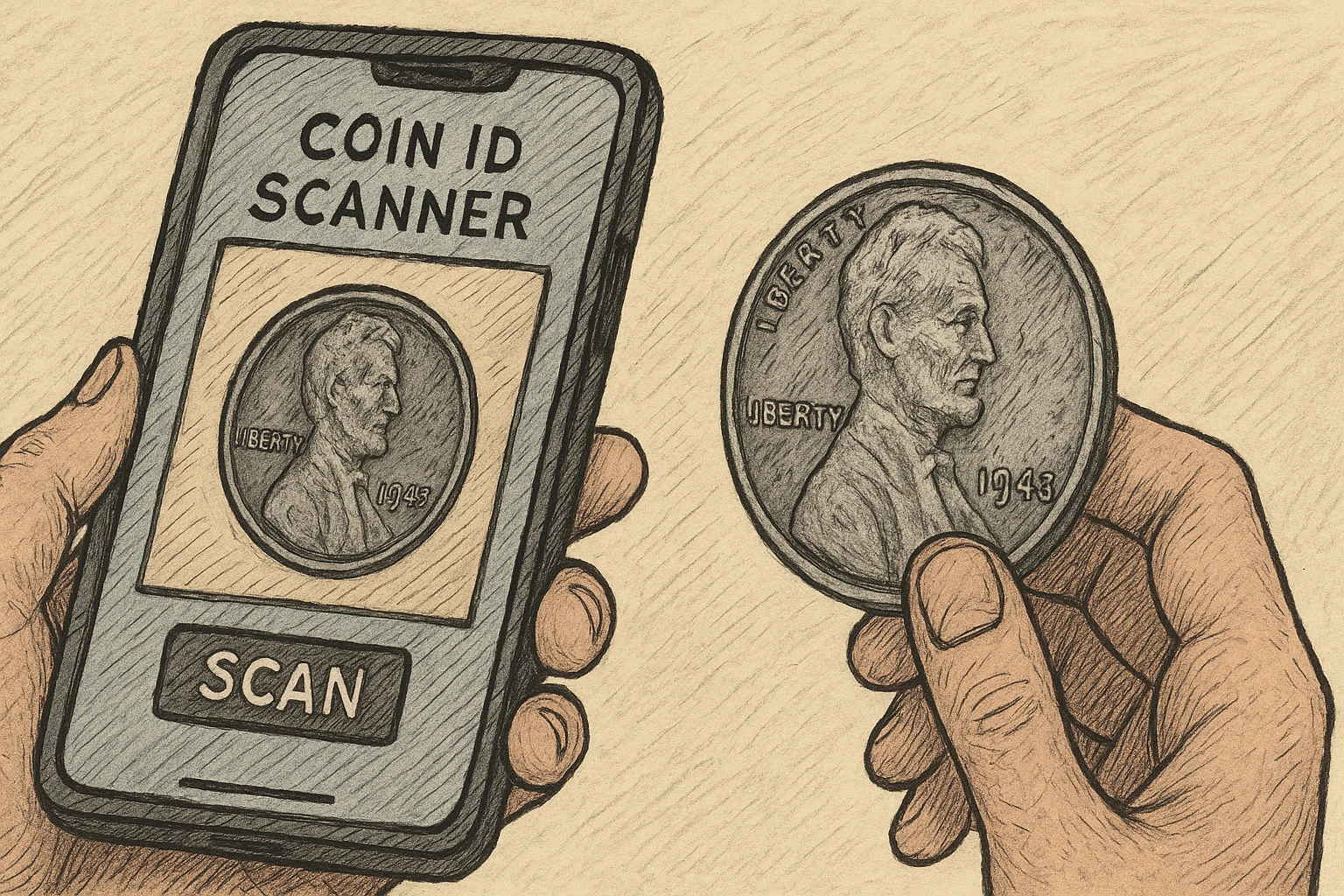In the midst of World War II, the U.S. Mint made a dramatic departure from tradition—a shift that left a permanent imprint on numismatic history. The year was 1943, and copper had suddenly become too valuable to spend on coins.
The U.S. military needed every ounce of it for shell casings, communications wire, and other wartime necessities. The result? A one-year-only experiment that produced one of the most distinct and discussed coins in U.S. history: the 1943 steel penny.
This wasn’t just a minor composition change. It was a bold, national-scale effort to support the war while ensuring that the penny, a fundamental unit of American currency, could continue to circulate. In doing so, the Mint not only addressed a logistical issue—it created a coin that has fascinated collectors and historians ever since.

Why Was the 1943 Steel Penny Made?
The steel penny’s creation is rooted in scarcity and ingenuity. When copper supplies tightened, the U.S. Mint sought alternatives and settled on steel plated with zinc. This combination ensured that the coin was strong, corrosion-resistant (to a point), and easy to manufacture.
The resulting coin stood out immediately: light gray in color, slightly lighter in weight (2.7 grams vs. 3.11 grams for a copper penny), and magnetically responsive.
For many Americans at the time, the shiny new pennies felt like a small, personal contribution to the war effort. Today, they represent a tangible piece of wartime life—a reminder of how even the smallest denomination adapted in response to global conflict.
What Makes the 1943 Steel Penny Unique?
Let’s break down why the 1943 steel penny isn’t just another obsolete coin:
| Feature | Details |
| Historical Context | Minted during WWII to save copper for ammunition and military equipment. |
| Material | Composed of 99% steel with a thin zinc coating. |
| Weight | 2.7 grams—lighter than standard copper pennies. |
| Magnetic | Attracts magnets—unique among U.S. pennies. |
| Design | Maintained Victor D. Brenner’s iconic Lincoln obverse and wheat reverse. |
| Mint Marks | Produced at Philadelphia (no mintmark), Denver (D), and San Francisco (S). |
These characteristics make the 1943 steel penny not only distinguishable from a visual standpoint, but also from a functional one. No other U.S. coin before or since has shared all of these traits. Its combination of historical background, unusual material, and fleeting production window ensures its continued popularity.
More Than Just a Metal Switch
What makes this coin truly remarkable is the context in which it was issued. It’s not just a novelty because it’s magnetic or silver in color—it’s a coin that tells a national story. The 1943 steel penny became a silent ambassador of wartime innovation, demonstrating how even the smallest decisions during World War II reflected a unified push toward victory.
Even the public reception was mixed and fascinating. Some Americans confused the steel pennies with dimes due to their color. Others disliked how quickly they rusted once the thin zinc layer wore off. As a result, the Mint returned to copper alloys in 1944, using recycled shell casings for a symbolic full-circle production process.
A Gateway for Collectors
Many collectors recall the 1943 steel penny as their first numismatic discovery—often found in an old change jar or passed down from a grandparent. Its accessibility, paired with its unique appearance and rich backstory, makes it an ideal entry point into the world of coin collecting.
Still, not all 1943 pennies are made equal. Most are common, but a few have exceptional qualities or errors that elevate their value significantly—details we’ll dive into in the next section. For now, understand that this coin’s value isn’t just in its monetary worth but in its connection to a pivotal moment in global and American history.
How Much Is a 1943 Steel Penny Worth?
Contrary to common myth, most 1943 steel pennies aren’t worth hundreds or thousands of dollars. In fact, the vast majority remain relatively affordable—but condition, mintmark, and minting errors can create surprising value shifts.
Below is a table outlining the estimated 2025 values based on condition and rarity:
| Grade / Type | Estimated Value (2025) |
| Circulated (average wear) | $0.10 – $0.50 |
| Uncirculated (Mint State 60) | $2 – $10 |
| High-Grade (MS65 and above) | $30 – $100+ |
| Doubled Die / Off-Center | $50 – $500+ (varies based on severity) |
| 1943 Copper Penny (error) | $100,000+ (ultra-rare; only a few known) |
Key Takeaways:
- Most steel cents are worth pocket change in circulated condition.
- Exceptionally preserved coins or those with dramatic mint errors can reach impressive prices.
- A genuine 1943 copper penny is one of the most valuable U.S. coin errors ever discovered—be wary of counterfeits, often made by copper-plating steel cents or altering dates.
What Are the Rarest 1943 Penny Errors?
Some error coins are worth watching for—these mistakes, made during the minting process, are prized by collectors due to their scarcity.
Top Errors to Look For:
- 1943 Copper Penny
- Not technically a steel penny, but accidentally struck on leftover copper planchets.
- Color: brownish or reddish, like normal pre-1943 cents.
- Strongly non-magnetic—this is the biggest giveaway.
- Value: $100,000+ depending on grade and mintmark (P, D, or S).
- Doubled Die Obverse (DDO)
- Most commonly seen on the date or “LIBERTY”.
- Look closely for shadow-like doubling under magnification.
- Value: $75 to $500+, depending on visibility and condition.
- Off-Center Strike
- Part of the design is missing, with a blank crescent on the coin.
- Value increases with the amount of off-center striking and how well the date is visible.
- Value: $50–$250+.
- Clipped Planchets or Die Cracks
- Unusual shapes or raised lines caused during striking.
- Value varies based on severity and clarity of the error.
These varieties are not only visually intriguing but can add substantial premium to otherwise common coins.
How to Identify a Real 1943 Steel Penny
With replicas, altered coins, and internet misinformation rampant, verifying authenticity is crucial—especially if you suspect you have a rare variety. Use this multi-step checklist:
| Test | What to Check |
| Magnet Test | A real steel penny will stick strongly to a magnet. If it doesn’t—it’s not steel. |
| Weight Test | Steel cents weigh approximately 2.70 grams. Copper versions weigh 3.11g. |
| Color Test | Steel coins have a silver-gray tone. Copper ones are reddish-brown or dark. |
| Sound Test | Drop test on a hard surface—steel cents sound duller than copper coins. |
| Date Inspection | Some fakes are made by altering a 1948 cent (the 8 reshaped into a 3). Look closely under magnification. |
| Third-Party Grading | Certified coins from PCGS, NGC, or ANACS guarantee authenticity and help determine value. |
These tests are your first line of defense before heading to a professional for verification.
A Modern Collector’s Edge: Tools for Identification and Organization
In the digital age, coin collecting has evolved beyond magnifying glasses and bulky books. One standout tool modern collectors use is the Coin ID Scanner—a mobile app designed to streamline the coin identification and cataloging process.

Coin ID Scanner Benefits for Steel Penny Collectors:
| Feature | Why It Matters for 1943 Steel Pennies |
| Photo-Based ID | Upload a snapshot and receive a complete profile of the coin, including its composition. |
| Value Estimation | Provides real-time value ranges based on condition, helping assess whether your coin is rare. |
| Collection Management | Digitally track your steel penny finds, add personal notes, and avoid duplicates. |
| AI Coin Helper | Ask questions about potential errors, grading, or history—and get AI-powered insights. |
| Database of 187,000+ Coins | Quickly compare your penny with global variants or spot a misidentified piece. |
Whether you’re identifying a newly discovered coin or verifying the authenticity of a passed-down heirloom, digital apps like Coin ID Scanner reduce the guesswork and enhance the collecting experience.
More Than a Collectible: A Learning Opportunity
The beauty of the 1943 steel penny lies in its ability to inspire curiosity. New collectors often stumble upon one in a family coin jar and immediately ask: Why does this penny look silver? Why is it magnetic? Could it be valuable?
Each question leads to a deeper dive into numismatics. And from that first mystery, a hobby can blossom.
For educators, it’s also an excellent gateway into topics like:
- WWII history and wartime resource allocation.
- Minting processes and how coins are struck.
- Material science, from zinc coating to steel core.
- Economic behavior, showing how currency adapts during crises.
Few coins straddle the line between artifact and educational tool so effectively.
The Collector’s Continuum: Where Old Meets New
One of the most compelling aspects of coin collecting in 2025 is how traditional practices now blend seamlessly with modern tools. You no longer need to haul out a dozen reference books or lug your collection in binders. Instead, mobile apps, high-resolution imaging, and AI-powered identification systems offer a sleek, accessible path to the same knowledge—sometimes even more.
Coin ID Scanner represents this shift perfectly. For collectors of the 1943 steel penny, it offers:
- Confidence in identification—no more second-guessing authenticity or mintmarks.
- Convenience in managing collections—whether you’re just getting started or maintaining a portfolio of hundreds of coins.
- Clarity when it comes to valuation, grading, and error detection—especially with subtle varieties like doubled dies or off-metal strikes.
By pairing digital tools with physical history, today’s collectors can preserve the past while using the best of the present.
Whether you’re a seasoned numismatist or a beginner holding a mysterious silver penny for the first time, the 1943 steel cent offers more than face value. It represents a nation’s resilience, a moment of ingenuity, and a spark of curiosity that can ignite a lifelong passion.
Here’s what makes it enduring:
| Why It Matters | Impact on Collectors and Culture |
| Historical Symbolism | A tangible artifact of the WWII homefront—accessible to all. |
| Educational Value | Teaches history, metallurgy, and economics through a real-world object. |
| Entry Point to Collecting | Easy to find, fascinating to research, fun to collect. |
| Potential for Treasure Hunting | Error coins and copper variants drive excitement and discovery. |
| Enhanced by Modern Tech | Tools like Coin ID Scanner empower collectors like never before. |
Coin collecting isn’t just about what you hold—it’s about what you uncover. Every 1943 steel penny has a backstory, whether it’s a war bond jar on the kitchen counter or a chance find in your pocket change. With the right mindset and tools, what seems like ordinary metal becomes a personal narrative—and maybe even a numismatic prize.
So check your change. Test your penny. Use your tools.Because somewhere, among the billions struck in 1943, your story might be waiting to be discovered.



